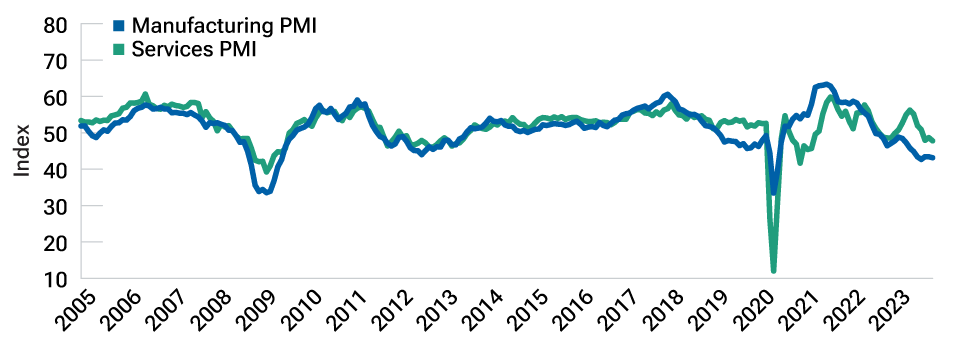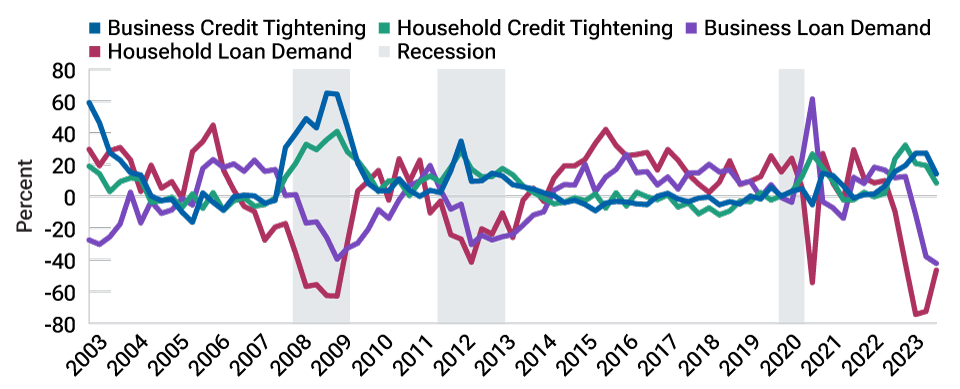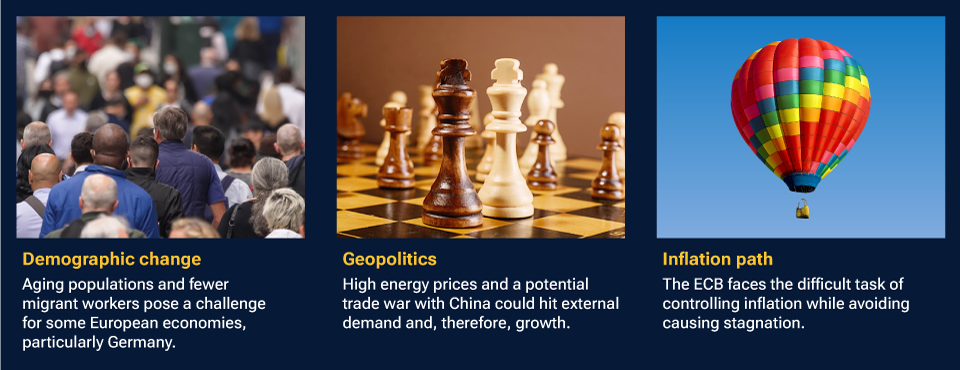28 Dec 2023
Europe must tread a fine line to avoid stagnation
Key Insights
Europe very likely faces several quarters of negative, or at least stagnating, growth in 2024. How long this period lasts will depend on several factors, but the most likely scenario is that the eurozone undergoes a mild to medium‑sized recession before returning to growth toward the end of next year. However, the risk of a more prolonged period of stagnation cannot be ruled out, particularly if the European Central Bank’s (ECB’s) monetary policy remains too tight for too long.
A faster‑than‑expected drop in inflation would likely prompt the ECB to cut rates sooner rather than later. This would favor German bunds but would weaken the euro. European stocks are likely to remain muted until the recovery begins, at which point cheap valuations may provide a buying opportunity.
Demographics pose challenge for eurozone’s biggest economies
Recent Purchasing Managers’ Index (PMI) surveys indicate that the European economy is already in recession. German manufacturing data are very weak, and French manufacturing PMIs have been falling to a similar level. Manufacturing PMIs in Italy and Spain have improved a little, but from very low levels. Services PMIs are weakening across the whole of the eurozone. Overall, these dynamics suggest that the currency bloc is close to the bottom of its manufacturing cycle but the deterioration in the services sector could have further to run (Figure 1).
The deterioration in services likely has further to run
(Fig. 1) The manufacturing cycle may already be close to the bottom

As of October 31, 2023.
Source: S&P Global. See Additional Disclosure.
Germany, Europe’s manufacturing motor, faces multiple challenges. In the 2000s, social benefit reforms significantly raised workforce participation rates among middle‑aged Germans, keeping wage levels competitive. European Union accession countries provided a further source of skilled and competitively priced labor, while Russia supplied cheap energy and Chinese just‑in‑time inputs allowed Germany to focus on higher value‑added manufacturing.
Since then, many of these tailwinds have turned into headwinds. Social benefits cannot be reformed much further, and there are fewer economic migrants. Germany needs approximately 400,000 immigrants each year to plug the gap in its workforce left by an aging population but is struggling to attract them. The economy is being slowly weaned off Russian gas, and some strategic supply chains are being reconfigured. These structural changes will keep growth in Germany subdued for several years while it transitions to a new economic model. In the past, fiscal policy would have been deployed to ease the pain during this process, but Germany’s debt brake rule means this is not feasible this time.
Italy will experience similar challenges to Germany on the manufacturing side, and, given its very high debt levels, the government is similarly constrained in its use of fiscal policy. France has an active industrial and fiscal policy, which will help to cushion the transition. France is the only large country in the eurozone with sustainable demographics, which means that it should be much less affected by population aging. Spain’s economy has a much smaller share of manufacturing than the other countries. It could still be affected by a eurozone‑wide services downturn, yet surveys indicate that the Spanish economy continues to be by far the most resilient.
Geopolitical tensions and rising yields weigh on growth
Geopolitical uncertainty will weigh on consumption and investment, particularly if energy prices surge again. The severity of this impact will depend on how national governments respond. If most or all of any rising prices are passed onto consumers, the resulting demand destruction will sharply reduce inflationary pressures and enable the ECB to ignore the spike in energy prices. If, however, governments respond to rising prices by cutting the fuel duty, the inflation that follows could put pressure on the ECB to tighten again.
Arguably the biggest future geopolitical risk is a trade war with China. Although some European countries are ready to impose tariffs on Chinese imports, others are more concerned about reduced access to the Chinese market. A trade war with China would hit external demand and, therefore, eurozone growth.
Tightening financial conditions also threaten growth (Figure 2). The ECB’s monetary policy has tightened financial conditions in the eurozone significantly: According to the central bank’s own bank lending survey, household and firm loan demand has fallen drastically, and credit conditions have tightened. Narrow and broad monetary aggregates have also declined outright in 2023—another indicator of a very tight monetary stance. These effects have been exacerbated by spillovers from the U.S., where concerns about higher monetary policy rates and a large amount of fiscal issuance have led to a persistent sell‑off in government bond markets.
Tighter financing conditions often preceded a recession
(Fig. 2) Credit conditions are tightening, albeit at a slower rate

As of September 30, 2023.
Source: ECB Bank Lending Survey
External pressures in the form of rising yields threaten to tighten financial conditions even further irrespective of any policy actions the ECB itself takes. In the worst‑case scenario, a rapid externally driven tightening in financial conditions could push eurozone sovereign yields to levels that would certainly lead to a significant undershoot of the inflation target. If that happens, the ECB may decide to cut the policy rate.
Tight financing conditions not only affect consumers and firms, but also governments—the recent large rise in bond yields has made borrowing more expensive, which will constrain fiscal spending and weigh on domestic consumption and business investment. However, this will be offset to some degree by external demand, which should remain supportive, particularly if the U.S. economy remains resilient. Growth spillover effects arising from any further fiscal or monetary stimulus in China would also likely benefit Europe.
ECB must walk a narrow path
As things stand, inflation should begin to fall in the coming months and into next year. Following the coronavirus pandemic, supply chain disruption fueled a burst of manufactured goods inflation. Supply chains have since normalized to a large extent, and manufactured goods prices are falling. In addition, the full impact of the ECB’s tightening on inflation will very likely only be felt in the second half of 2024. In the absence of further commodity shocks, inflation may fall more quickly toward the ECB’s 2% target than currently anticipated. In our view, the risks that inflation undershoots the ECB’s 2% target are larger than currently anticipated.
The biggest risk for the eurozone is a return to pre‑pandemic‑era stagnation. This is a bigger risk than persistent inflation from second‑round effects. Following the global financial crisis, the currency bloc became mired in a low‑inflation, low‑growth equilibrium. The ECB has since set an inflation target of 2%, but this was a level it struggled to reach for almost a decade prior to the pandemic despite more than EUR 1 trillion worth of quantitative easing. If the ECB tightens too quickly, it could cause inflation to plummet back below 2%, pushing the eurozone into stagnation once again.
This is not a small risk: The eurozone’s manufacturing sector needs to transition away from cheap imported gas and labor, which is a major structural challenge. Normally, fiscal policy would be used to stimulate demand enough to ensure this supply adjustment occurs in an orderly fashion, but the eurozone is fiscally constrained. The ECB, therefore, faces the delicate task of carefully calibrating its monetary policy so that it is tight enough to keep inflation on a path consistent with its 2% inflation target in the medium term, but not so tight that it causes persistent stagnation. This is a narrow path to tread.
Ultimately, there are two scenarios in which the ECB is likely to initiate a rate‑cutting cycle: first, if growth is weaker than expected; and second, if inflation falls back to the 2% target faster than expected. Only one of these scenarios needs to materialize for the ECB to cut rates in our view. Our preference is therefore to be long German bunds, which we expect would be the main beneficiary of rate cuts in Europe. We believe that the ECB will eventually end up cutting between 150bps and 250bps, more than markets expect. As a result, assuming our expectations are correct, the euro is likely to decline relative to a broad basket of currencies in the coming year.
In equities, corporate profit margins will remain under pressure while economic conditions remain weak. If Europe avoids stagnation and returns to growth, opportunities may arise to invest in strong companies whose valuations will likely still be relatively cheap.
Weak UK data point to early rate cut
Outside of the European Union, the Bank of England (BoE) is expecting the UK economy to flatline until early 2025 but has warned it is “much too early” to think about rate cuts. Indeed, UK inflation has turned out to be more persistent than in other economies. The official measure of wage growth continues to grow at roughly 8% year on year, which is significantly above the level required to return inflation to target in the medium term.
However, it also needs to be acknowledged that surveys on the housing market, consumer confidence, manufacturing, and services activity are all at levels that were historically consistent with a recession. The BoE’s Monetary Policy Committee has a mandate to deliver inflation at 2%. But monetary policy that pushes the economy into deep recession may lead to a prolonged inflation target undershoot, which is equally undesirable to an inflation overshoot. The Bank of England, like the ECB, therefore faces a very difficult balancing act.
How this balancing act will play out really depends on the labor market. Historically, once the unemployment rate has begun to rise as it has in the past year, it has continued to rise to much higher levels. The Bank of England has predicted that the UK’s unemployment rate will rise only gradually, by 0.1% per quarter to a peak of 5.1% in the fourth quarter of 2026. I believe that this is too optimistic and that the unemployment rate will rise faster than the BoE expects. If I am right, the BoE is likely to cut rates faster than the market currently anticipates.
Key challenges for European economies in 2024
The Continent faces three strong headwinds

Source: T. Rowe Price.
Additional Disclosure
Copyright © 2023, S&P Global Market Intelligence (and its affiliates, as applicable). Reproduction of any information, data or material, including ratings (“Content”) in any form is prohibited except with the prior written permission of the relevant party. Such party, its affiliates and suppliers (“Content Providers”) do not guarantee the accuracy, adequacy, completeness, timeliness or availability of any Content and are not responsible for any errors or omissions (negligent or otherwise), regardless of the cause, or for the results obtained from the use of such Content. In no event shall Content Providers be liable for any damages, costs, expenses, legal fees, or losses (including lost income or lost profit and opportunity costs) in connection with any use of the Content. A reference to a particular investment or security, a rating or any observation concerning an investment that is part of the Content is not a recommendation to buy, sell or hold such investment or security, does not address the suitability of an investment or security and should not be relied on as investment advice. Credit ratings are statements of opinions and are not statements of fact.